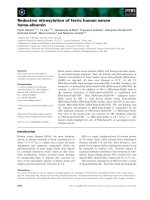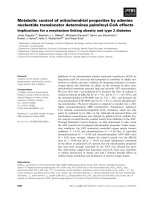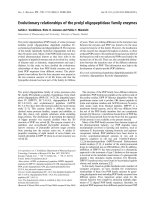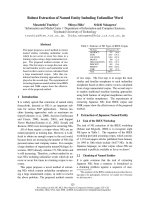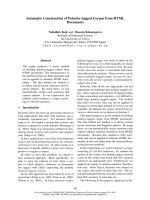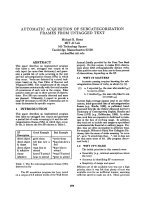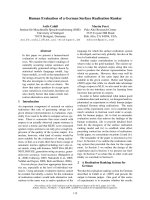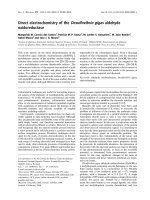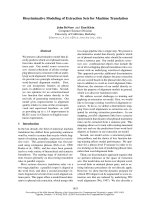Báo cáo khoa học: "Integrated Control of Chart Items for Error Repair" doc
Bạn đang xem bản rút gọn của tài liệu. Xem và tải ngay bản đầy đủ của tài liệu tại đây (595.48 KB, 7 trang )
Integrated Control of Chart Items for Error Repair
Kyongho MIN and William H. WILSON
School of Computer Science & Engineering
University of New South Wales
Sydney NSW 2052 Australia
{ min,billw } @cse.unsw.edu.au
Abstract
This paper describes a system that
performs hierarchical error repair for ill-
formed sentences, with heterarchical
control of chart items produced at the
lexical, syntactic, and semantic levels. The
system uses an augmented context-free
grammar and employs a bidirectional chart
parsing algorithm. The system is
composed of four subsystems: for lexical,
syntactic, surface case, and semantic
processing. The subsystems are controlled
by an integrated-agenda system. The
system employs a parser for well-formed
sentences and a second parser for repairing
single error sentences. The system ranks
possible repairs by penalty scores which
are based on both grammar-dependent
factors (e.g. the significance of the
repaired constituent in a local tree) and
grammar-independent factors (e.g. error
types). This paper focuses on the
heterarchical processing of integrated-
agenda items (i.e. chart items) at three
levels, in the context of single error
recovery.
Introduction
Weischedel and Sondheimer (1983) described
two types of ill-formedness: relative (i.e.
limitations of the computer system) and
absolute (e.g. misspellings, mistyping,
agreement violation etc). These two types of
problem cause ill-formedness of a sentence at
various levels, including typographical,
orthographical, morphological, phonological,
syntactic, semantic, and pragmatic levels.
Typographical spelling errors have been
studied by many people (Damerau, 1964;
Peterson, 1980; Pollock and Zamora, 1983).
Mitton (1987) found a large proportion of
real-word errors were orthographical: to >
too, were > where. At the sentential level,
types of syntactic errors such as co-occurrence
violations, ellipsis, conjunction errors, and
extraneous terms have been studied (Young,
Eastman, and Oakman, 1991). In addition,
Min (1996) found 0.6% of words misspelt
(447/68966) in 300 email messages, leading to
about 12.0% of the 3728 sentences having-
errors.
Various systems have focused on the
recovery of ill-formed text at the morpho-
syntactic level (Vosse, 1992), the syntactic
level (Irons, 1963; Lyon, 1974), and the
semantic level (Fass and Wilks, 1983;
Carbonell and Hayes, 1983). Those systems
identified and repaired errors in various ways,
including using grammar-specific rules (meta-
rules) (Weischedel and Sondheimer, 1983),
least-cost error recovery based on chart
parsing (Lyon, 1974; Anderson and
Backhouse, 1981), semantic preferences (Fass
and Wilks, 1983), and heuristic approaches
based on a shift-reduce parser (Vosse, 1992).
Systems that focus on a particular level miss
errors that can only be detected using higher
level knowledge. For example, at the lexical
level, in I saw a man if the park, the misspelt
word if is undetected. At the syntactic level, in
I saw a man in the pork, the misspelling of
pork can only be detected using semantic
information.
This paper describes the automatic
correction of ill-formed sentences by using
integrated information from three levels
(lexical, syntactic, and semantic). The
CHAPTER system (CHArt Parser for Two-
stage Error Recovery), performs two-stage
error recovery using generalised top-down
chart parsing for the syntax phase (cf. Mellish,
1989; Kato, 1994). It uses an augmented
context-free grammar, which covers verb
subcategorisations, passives, yes/no and WH-
questions, finite relative clauses, and
EQUI/SOR phenomena.
The semantic processing uses a conceptual
hierarchy and act templates (Fass and Wilks,
1983), that express semantic restrictions.
Surface case processing is used to help extract
meaning (Grishman and Peng, 1988) by
mapping surface cases to their corresponding
conceptual cases. Unlike other systems that
862
have focused on error recovery at a particular
level (Damerau, 1964; Mellish, 1989; Fass and
Wilks, 1983), CHAPTER uses an integrated
agenda system, which integrates lexical,
syntactic, surface case, and semantic
processing. CHAPTER uses syntactic and
semantic information to correct spelling errors
detected, including real-word errors.
Section 1 treats methodology. Section 2 gives
test results for CHAPTER. Section 3 describes
problems with CHAPTER and section 4
contains conclusions.
1 Methodology
The system uses a hierarchical approach and
an integrated-agenda system, for efficiency in
an environment where most sentences do not
have errors. The first stage parses an input
sentence using a bottom-up left-to-right chart
parsing algorithm incorporating surface case
and semantic processing. If no parse is found,
the second stage tries to repair a single error:
either at the lexical or syntactic level (§1.1) or
at the semantic level (§ 1.2). The second parser
uses generalised top-down strategies (Mellish,
1989) and a restricted bidirectional algorithm
(Satta and Stock, 1994) for error detection and
correction.
Errors at the syntactic level are assumed to
arise from replacement of a word by a known
or unknown word, addition of a known or
unknown word, or deletion of a word. Real-
word replacement errors may occur because of
simple misspellings, or agreement violations. A
semantic error is signalled if a filler concept
violates the semantic constraints of the concept
frame for a sentence.
1.1 Syntactic Recovery
CHAPTER's syntactic error recovery system
employs generalised top-down and
bidirectional bottom-up chart parsing (cf.
Mellish, 1989) using an augmented context-
free grammar. The system is composed of two
phases: error detection and error correction
(see section 4 in Min, 1996). A single syntactic
error is detected by the following two
processes:
(1) top-down expectation: expands a goal
using an augmented context-free
grammar. (A goal is a partial tree, which
may contain one or more syntactic
categories, specifically a subtree of a
syntax tree corresponding to a single
context-free rule, and which might
contain syntactic errors. For example,
the first goal for the ill-formed sentence
I have a bif book is <S needs from 0 to
5 with penalty score 4>.)
(2) bottom-up satisfaction: searches for an
error using a goal and inactive arcs
made by the first-stage parser, and
produces a need-chart network;
The error detected by this process is corrected
by the following two processes:
(3) a constituent reconstruction engine:
repairs the error and reconstructs local
trees by retracing the need-chart
network; and
(4) spelling correction corrects spelling
errors (see Min and Wilson, 1995).
Because of space limitations, this paper focuses
on (3) and (4).
Consider the sentence I saw a man if the
park. The top-down expectation phase would
produce the initial goal for the sentence, <goal
S is needed from 0 to 7>, and expand it using
grammar rules, <(S > NP VP) is needed from
0 to 7>. Next, a bottom-up satisfaction phase
uses the inactive arcs left behind by the first-
stage parser to refine and localise the error by
looking for the leftmost or rightmost
constituent of the expanded goal in a
bidirectional mode.
For example, given an inactive arc, <NPCI")
from 0 to 1>, the left-to-right process is
applied: for the expanded goal S, NP ('T') is
found from 0 to 1 and VP is needed from 1 to
7: or, more briefly, <S > NP('T') • VP is
needed from 1 to 7>. This data structure is
called a need-arc. A need-arc is similar to an
active arc, and it includes the following
information: which constituents are already
found and which constituents are needed for
the recovery of a local tree between two
positions, together with the arc's penalty score.
From this need-arc, another goal, <goal VP is
needed from 1 to 7>, is produced.
After detecting an error using the top-down
expectation and bottom-up satisfaction phases,
the detected error is corrected using two types
of chart item: a goal and a need-arc, and the
types of the goal's or need-arc's constituent
and its penalty score. The penalty score
(PS(G)) of a goal (or need-arc) G, whose
syntactic category is L and whose two
positions are FROM and TO, is computed as
follows:
PS(G) = RW(G) - MEL(L)
where RW(G) is the number of remaining
words to be processed, (ie. TO - FROM),
and MEL(L) is the minimal extension
length of the category L.
863
MEL (Minimal Extension Length) is the
minimum number of preterminals necessary
to produce the rule's LHS category. For
example, the MEL of S is 2, because of
examples like "I go".
Using the penalty scores, three error
correction conditions are as follows:
• The substitution
correction condition is:
the goal's label is a single lexical category,
and its penalty score is 0 (there is a
replaced word)
• The addition
correction condition is:
the goal's label is a single lexical category,
and its penalty score is -1 (there is an
omitted word).
• The deletion
correction condition is:
there is no constituent needed for repair,
and the penalty score of the need-arc is 1
(there is an extra word).
The repaired constituent produced with these
conditions is used to repair constituents all the
way up to the original S goal via the need-
chart network. This process is performed by
the constituent reconstruction engine.
At the syntactic level, the choice of the best
correction relies on two penalty schemes:
error-type penalties and penalties based on the
weight (or importance) of the repaired
constituent in its local tree. The error-type
penalties are 0.5 for substitution errors, and 1
for deletion or addition errors 1. The weight
penalty of a repaired constituent in a local tree
is either 0.1 for a head daughter, 0.5 for a
non-head daughter, or 0.3 for a recursive
head-daughter (e.g. NP in the right-hand side
of the rule NP > NP PP). The weight penalty
is accumulated while retracing the need-chart
network. In effect, the system seeks a best
repair with minimal length path from node S
to the error location in the syntax tree.
Often more than one repair is suggested. The
repaired syntactic structures are subject to
surface case and semantic processing during
syntactic reconstruction. If the syntactic repair
does not violate selectional restrictions, it is
acceptable.
1.2 Semantic Recovery
CHAPTER maps syntactic parses into surface
case frames. These are interpreted by a
mapping procedure and a pattern matching
algorithm. The mapping procedure uses
semantic selectional restrictions based on act
templates and a concept hierarchy and
converts the surface case slots into concept
IThe~ penalties are somewhat arbitrary. Corpus-based
probability estimates would be preferable.
slots, while the pattern matching algorithm
constrains filler concepts using ACT templates
which represents semantic selectional
restrictions. Selectional restrictions are
represented by a expressions like ANIMATE,
or (NOT HUMAN). The latter represents any
concept that is not a sub-concept of HUMAN.
Surface cases are mapped to concept slots:
subject > agent, verb > act, direct object
theme. Consider the sentence "I parked a car".
The mapping of SENTI into PARK1 is as
follows:
SENTI: (subj (value 'T'))
(verb (value "parked"))
(dobj (value "a car"))
PARKI: (agent (SPEAKER 'T'))
(act (PARK "parked"))
(theme (CAR "a car"))
Semantic errors may be of two types:
(1) there may be no full parse tree, so
semantic interpretation is impossible;
(2) the sentence may be syntactically
acceptable, but semantically ill-formed
(e.g.
I parked a bud
(bus)).
The first type of error is repaired from the
spelling level up to semantic level (if a spelling
error is detected). For errors of a semantic
nature, semantic selectional restrictions may be
forced onto the error concept to make it fit the
template. For example, the sentence
"I parked
a bud"
violates the semantic selectional
restriction on the theme slot of
park. The
template of the verb
park
is (HUMAN PARK
VEHICLE). However, the concept BUD,
associated with 'bud', is not consistent with the
restriction, VEHICLE, on the theme slot. As a
result, the sentence is semantically ill-formed,
with a semantic penalty of-1 (one slot violates
a restriction). To correct the error, the filler
concept BUD is forced to satisfy the template
concept VEHICLE by invoking the spelling
corrector with the word 'bud' and the concept
VEHICLE. Thus the real word error
bud
would be corrected to
bus.
The filler concept may itself be internally
inconsistent. Consider the sentence
I saw a
pregnant man. The
theme slot of SEE satisfies
its restriction. However, the filler concept of
the theme slot is inconsistent. In CHAPTER,
the attribute concept
pregnant
is identified as
the error rather than the head concept
man.
To
correct it, the attribute concept is relaxed to
any attribute concept that can qualify the
MAN concept. It would also be possible to
force
man
to fit to the attribute concept (e.g.
by changing it to
woman).
There seems to be
no general method to pick the correct
component to modify with this type of error:
864
we chose to relax the attribute concept. This
problem might be resolved by pragmatic
processing.
1.3
Integrated-Agenda Manager
CHAPTER is composed of four subsystems for
parsing well-formed sentences and repairing
ill-formed sentences: lexical, syntactic, surface
case, and semantic processing. Each subsystem
uses relevant chart items from other
subsystems as its input and is invoked in a
heterarchical mode byan agenda scheme,
which is called the integrated-agenda manager.
The manager controls and integrates all levels
of information to parse well-formed sentences
and repair ill-formed sentences (Min, 1996).
Thus the integrated-agenda manager
distributes agenda items to relevant subsystems
(see Figure 1).
~
genda items t.~
I syntactic sem,~nuc
item I I surlace '
caseiteml[ item ]
~syntac~c
I surface casel I
semantic
ocesslng I
I processing I
[processing
[ ~ew ch!rt item ~
Figure
1. Integrated agenda manager
For example, if an agenda item is a repaired
syntactic item, then it is distributed to syntactic
processing for recovery, then to surface case
and semantic processing. The invocation of
the relevant subsystem depends on the
characteristics of the chart item. Consider an
agenda item which is a syntactic NP node.
Syntactic and subsequently semantic
processing are invoked. Surface case
processing is not appropriate for an NP node.
If an agenda item is a syntactic VP node, then
syntactic, surface case, and semantic
processing are all invoked. After subsystem
processing of the item, the new chart item
becomes an agenda item in turn. This
continues until the integrated agenda is empty.
The data structures of CHAPTER are based on
a network-like structure that allows access to all
levels of information (syntactic, surface case,
and semantics). Some of the data are stored
using associative structures (e.g. grammar
rules, active arcs, and inactive arcs) that allow
direct access to structures most likely to be
needed during processing.
2 Experimental
Results
The test data included syntactic errors
introduced by substitution of an unknown or
known word, addition of an unknown or
known word, deletion of a word, segmentation
and punctuation problems, and semantic
errors. Data sets we used are identified
as:
NED (a mix of errors from Novels, Electronic
mail, and an (electronic) Diary); Applingl,
and Peters2 (the Birkbeck data from Oxford
Text Archive (Mitton, 1987)); and Thesprev.
Thesprev was a scanned version of an
anonymous humorous article titled "Thesis
Prevention: Advice to PhD Supervisors: The
Siblings of Perpetual Prototyping".
In all, 258 ill-formed sentences were tested:
153 from the NED data, 13 from Thesprev, 74
from Applingl, and 18 from Peters2. The
syntactic grammar covered 166 (64.3%) of the
manually corrected versions of the 258
sentences. The average parsing time was 3.2
seconds. Syntactic processing produced on
average 1.7 parse trees 2, of which 0.4 syntactic
parse trees were filtered out by semantic
processing. Semantic processing produced 9.3
concepts on average per S node, and 7.3 of
them on average were ill-formed. So many
were produced because CHAPTER generated a
semantic concept whether it was semantically
ill-formed or not, to assist with the repair of ill-
formed sentences (Fass and Wilks, 1983).
Across the 4 data sets, about one-third of
the (manually-corrected) sentences were
outside the coverage of the grammar and lex-
icon. The most common reasons were that the
sentences included a conjunction ("He places
them face down
so that
they are a surprise"), a
phrasal verb CI
called out
to Fred and went
inside"), or a compound noun ("P C
development tools are
far ahead of
Unix
development tools"). The
remaining 182
sentences were used for testing: NED (98/153);
Thesprev (12/13); Applingl (55/74); and
Peters2 (17/18). Compound and compound-
complex sentences in NED were split into
simple sentences to collect 13 more ill-formed
sentences for testing.
2There are so few parse trees because of the use of
subcategorisation and the augmented context-free
grammar (the number of parse trees ranges from 1 to
7).
865
Table 1 shows that 89.9% of these ill-
formed sentences were repaired. Among these,
CHAPTER ranked the correct repair first or
second in 79.3% of cases (see 'best repair'
column in Table 1). The ranking was based on
penalty schemes at three levels: lexical,
syntactic, and semantic. If the correct repair
was ranked lower than second among the
repairs suggested, then it is counted under
'other repairs' in Table 1. In the case of the
NED data, the 'other repairs' include 11 cases
of incorrect repairs introduced by:
segmentation errors, apostrophe errors,
semantic errors, and phrasal verbs. Thus for
about 71% of all ill-formed sentences tested,
the correct repair ranked first or second
among the repairs suggested. For 19% of the
sentences tested, incorrect repairs were ranked
as the best repairs. A sentence was considered
to be "correctly repaired" if any of the
suggested corrections was the same as the one
obtained by manual correction
Table 2 shows further statistics on
CHAPTER's performance. CHAPTER took
18.8 seconds on average 3 to repair an ill-
formed sentence; suggested an average of 6.4
repaired parse trees; an average of 3 repairs
were filtered out by semantic processing.
During semantic processing, an average of
40.3 semantic concepts were suggested for
each S node. An average 34.3 concepts per S
node were classified as ill-formed. Twenty
seven percent of the
'best'
parse trees suggested
by CHAPTER's ranking strategy at the
syntactic level were filtered out by semantic
processing. The remaining 73% of the
'best'
parse trees were judged semantically well-
formed.
In the case of the NED data set, 90 ill-
formed sentences were repaired. On average:
recovery time per sentence was 23.9 seconds;
9.8 repaired S trees per sentence were
produced; 4.5 of the 9.8 repaired S trees were
semantically well-formed; 95.1 repaired
concepts (ill-formed and well-formed) were
produced; 8.5 of 95.1 repaired concepts were
well-formed; and semantic processing filtered
syntactically best repairs, removing 22% of
repaired sentences. The number of repaired
concepts for S is very large because semantic
processing at present supports interpretation of
only a single verbal (or verb phrasal) adjuncts.
For example, the template of the verb GO
allows either a temporal or destination adjunct
at present and ignores any second or later
adjunct. Thus a GO sentence would be
interpreted using both [THING GO DEST]
and [THING GO TIME].
3 Discussion
3.1 Syntactic Level Problems
The grammar rules need extension to cover
the following grammatical phenomena:
compound nouns and adjectives, gerunds,
TO+VP, conjunctions, comparatives, phrasal
verbs and idiomatic sentences. For example,
'in the morning' and 'at midnight' are well-
formed phrases. However, CHAPTER
currently also parses 'in morning', 'in the
midnight', and 'at morning' as well-formed.
CHAPTER uses prioritised search to detect and
correct syntactic errors using the penalty
scores of goals. However, the scheme for
selecting the best repair did not uncritically use
the first detected error found by the prioritised
search at the syntactic level, because the best
repair might be ill-formed at the semantic
level. In fact, the prioritised search strategy did
not contribute to the selection scheme, which
depended solely on the error type and the
importance of the repaired constituent in its
local tree.
3.2 Semantic Level Problems
At present in CHAPTER's semantic system,
the most complex problem is the processing of
prepositions, and their conceptual definition.
For example, the preposition 'for' can
indicate at least three major concepts: time
duration
(for a week),
beneficiary
(for his
mother),
and purpose
(for digging holes).
If
for
takes a gerund object, then the concept will
specify a purpose or reason (e.g.
It is a
machine for slicing bread).
In addition, the act templates do not allow
multiple optional conceptual cases (i.e.
relational conceptual cases - LOC for
Ideational concepts, and DEST for destination
concepts, etc.) for prepositional and adverbial
phrases. This would increase the number of
templates and the computational cost. If there
is more than one verbal adjunct (PPs and
ADVPs) in a sentence, then CHAPTER does
not interpret all adjuncts.
3Running under Macintosh Common Lisp v 2.0 on a
Macintosh II fx with 10 MB for Lisp
866
Data Set
NED (%)
Appling 1 (%)
Peters2 (%)
Thesprev (%)
Average (%)
Sentences
tested
98
55
17
12
Number of
repairs
90 (91.8)
52 (94.5)
17 (100)
10 (83.3)
* 89.9%
Best repairs
64/90 (71.1)
40/52 (76,9)
14/17 (82.4)
9/10 (90.0)
79.3%
Other repairs
26/90 (28.9)
12/52 (23.1)
3/17 (17.6)
1/10 (10.0)
20.7%
No repairs
suggested
8 (8.2)
3 (5.5)
0
2 (16.7)
10.1%
Table 1. Performance of CHAPTER on ill-formed sentences
*Peters2 data are not considered in the averages because Peters2 consists of only the sentences that were covered by
CHAPTER's grammar, selected from more than 300 sentence fragments (simple sentences and phrases.)
Data set [ Sentences I Time I Repaired
I
repaired [ (sec) I S trees
ar r'ami 1¢i I
Semantically Repaired Repaired well- % of syntactic-
well-formed concepts formed ally-best parses
for S ~ filtered
4.5 95.1 8.5
7"TTZr 7
Z3 " 3-if
'77Z 7 ""-'fTF"
3.4 40.3 6.0 46/169 (27%)
Table 2. Results on CHAPTER's performance (average values per sentence)
Conclusion
This paper has presented a hierarchical error
recovery system, CHAPTER, based on a chart
parsing algorithm using an augmented
context-free grammar. CHAPTER uses an
integrated-agenda manager that invokes
subsystems incrementally at four levels:
lexical, syntactic, surface case, and semantic. A
sentence has been confirmed as well-formed
or repaired when it has been processed at all
levels.
Semantic processing performs pattern
matching using a concept hierarchy and verb
templates (which specify semantic selectional
restrictions). In addition, procedural semantic
constraints have been used to improve the
efficiency of semantic processing based on a
concept hierarchy. However, it increases
computational cost.
CHAPTER repaired 89.9% of the ill-formed
sentences on which it was tested, and in 79.3%
of cases suggested the correct repair (as judged
by a human) as the best of its alternatives.
CHAPTER's semantic processing rejected 27%
of the repairs judged "best" by the syntactic
system.
References
Anderson, S. and Backhouse, R. (1981). Locally
Least-cost Error Recovery in Earley's Algorithm.
ACM Transactions on Programming I_zmguages and
Systems, 3(3) 318-347.
Carbonell, J. and Hayes, P. (1983). Recovery
Strategies for Parsing Extragrammatical
Language. American Journal of Computational
Linguistics, 9(3-4) 123-146.
Damerau, F. (1964). A Technique for Computer
Detection and Correction of Spelling Errors.
Communications of the ACM, 7(3) 171-176.
Fass, D. and Wilks, Y. (1983). Preference Semantics,
Ill-formedness, and Metaphor. American Journal
of Computational Linguistics, 9(3-4) 178-187.
Grishman, R. and Peng, P. (1988). Responding to
Semantically Ill-Formed Input. The 2nd
Conference of Applied Natural Language
Processing, 65-70.
Irons, E. (1963). An Error-Correcting Parse
Algorithm. Communications of the ACM, 6(11)
669-673.
Kato, T. (1994). Yet Another Chart-Based Technique
for Parsing Ill-formed Input. The Fourth
867
Conference on Applied Natural Language
Processing, 107-112.
Lyon, G. (1974). Syntax-Directed Least-Errors
Analysis for Context-Free Languages: A Practical
Approach. Convnunications of the A CM, 17(1)
3-14.
Mellish, C. (1989). Some Chart-Based Techniques for
Parsing Ill-Formed Input. ACL Proceedings, 27th
Annual Meeting, 102-109.
Min. (1996). Hierarchical error recovery based on
bidirectional chart parsing techniques. PhD
dissertation, University of UNSW, Sydney,
Australia.
Min, K. and Wilson, W. H. (1995). Are Efficient
Natural Language Parsers Robust?. Eighth
Australian Joint Conference on Artificial
Intelligence; 283-290
Mitton, R. (1987). Spelling Checkers, Spelling
Correctors and the Misspellings of Poor Spellers.
Information Processing and Management, 23(5)
495-505.
Peterson, J. (1980). Computer Programs for Det-
ecting and Correcting Spelling Errors. Com-
munications of the ACM, 23(12) 676-687.
Pollock and Zamora (1983). Collection and
characterisation of spelling errors in scientific and
scholarly text. Journal of the American Society for
Information Science. 34(1) 51-58.
Satta and Stock (1994). Bidirectional context-free
grammar parsing for natural language processing.
Artificial Intelligence 69 123 - 164.
Vosse, T. (1992). Detecting and Correcting Morpho-
Syntactic Errors in Real Texts. The Third
Conference on Applied Natural Language
Processing, 111-118.
Weischedel, R. and Sondheimer, N. (1983). Meta-
rules as Basis for Processing Ill-formed Input.
American Journal of Computational Linguistics,
9(3-4) 161-177.
Young, C., Eastman, C., and Oakman, R. (1991). An
Analysis of Ill-formed Input in Natural Language
Queries to Document Retrieval Systems.
Information Processing and Management, 27(6)
615-622.
868
